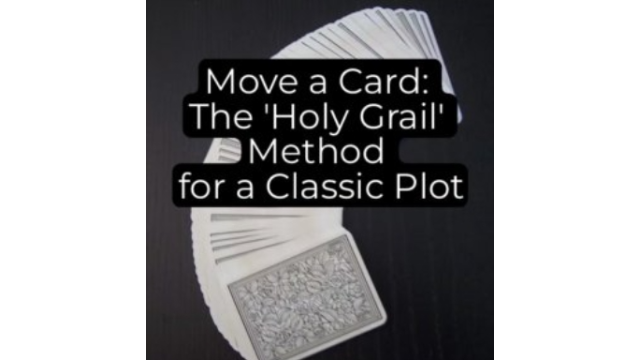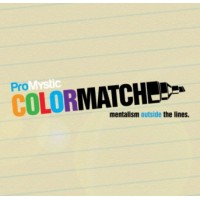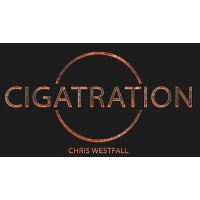Move a Card: the 'Holy Grail' method for a classic plot by Unnamed Magician
- Product Code: #e11083
- Reward Points: 5
- Availability: In Stock
- $15.00
-
$1.99
- Price in reward points: 199
"Pretty sure Moe would have been fooled by this." - Ryan Schlutz
"A clever method for a memory demonstration." - Christian Grace
Note: The effect described below makes up less than half of the entire e-book. The rest of the e-book contains several other methods for the "Move a Card" plot.
The "Move a Card" plot goes all the way back to at least the 1930s, when it was popularized by Moe Seidenstein. Over the decades, many methods have been developed. But I believe this method is the 'Holy Grail' method, simply because of its impossible conditions. Among other conditions, any borrowed deck can be used, the effect is completely impromptu, and the effect is 100% hands-off (you never need to touch a single card).
There is a full performance video below (thanks to my friend for recording it), but here is a complete written description as well (along with the conditions):
Imagine:
The magician asks the spectator for their own deck of cards as he wishes to use a borrowed deck for the routine. He invites them to thoroughly shuffle the cards in any way of their choosing. The spectator does that. (The magician also promises never to touch the cards at any point in time.)
Once the spectator is done shuffling, the magician invites them to spread the deck face-up on the table so that he can try and memorize the order of the shuffled cards. After he's looked through the cards, he turns his back to the spectator.
The magician says (while turned away), "Take out any card from one side of the face-up spread and move it to the other side to a totally different location." After this is done, he continues, "Now I want you to square up the face-up spread in order to eliminate any evidence of where the card might've been moved from or moved to." The spectator does that.
Once they're done, the magician turns back around to face them. He then explains that if he did in fact memorize the order of all the cards, he should be able to identify which card was moved. So he asks the spectator to spread the deck face-up on the table again.
And, after some time of thinking, the magician reveals the name of the moved card without any fishing.
Some important conditions of note:
- The effect uses a borrowed, shuffled deck.
- The magician never touches the cards at any point in time, whether before, during, or even after the effect (so this can be performed over a video call with the deck on the spectator's end).
- There are no gimmicks of any kind involved - this is 100% impromptu.
- There is very little memory work involved (within reach of anyone) - so the magician doesn't need to memorize a bunch of cards or anything like that.
- The magician doesn't learn the identity of the selected card until he looks through the face-up spread at the end - so this rules out any peek or force.
- The magician never needs to fish for any information at the end - he can always reveal the identity of the selected card without fishing or asking questions.
Reviews (0)
Related Products
Stella by Yusuke Asada
Yusuke Asada - Stella Demonstration effect : https://www.frenchdrop.com/detail?id=2213 Classic plo..
$1.99 $4.99
Matrix Coin Assemblies by Wgm
The world's best Magic series coin matrix WGM - Matrix Coin Assemblies series is a collection of ..
$1.99 $4.99
Cannibal Cards by Wgm
The world's best magic cards magic series greedy WGM - Cannibal Cards Demonstration effect : htt..
$1.99 $4.99
Prophet by Tom Isaacson
Theory11 - Tom Isaacson - Prophet Demonstration effect : http://media.theory11.com/1100-Prophet---..
$1.69 $3.98
Moving Cards by Sean Taylor
A pack of cards is shuffled, and spread face-up on the table. The magician glances across the spread..
$3.99 $8.48
Making The Cut by Ryan Schlutz
\ "I've known Ryan for more than a few years now. He's one of those guys who annoys the crud out of ..
$4.99 $14.68
Roberto Giobbi Penguin Live Online Lecture
Site lectures Penguin Live Online Lecture - Roberto Giobbi One of the finest teachers of magic ever..
$1.99 $5.99
Illusive Actions by Robert Moreland
Robert Moreland - Illusive Actions Demonstration effect : http://www.youtube.com/watch?v=MS2-XP..
$1.69 $3.98
More Elegant Card Magic by Rafael Benatar
Rafael Benatar - More Elegant Card Magic From Rafael Benatar more elegant poker magic. Video Demo: h..
$1.69 $3.98
Elegant Card Magic (1-2) by Rafael Benatar
Rafael Benatar - Elegant Card Magic (1-2) From Venezuela magician Rafael Benatar, elegant ca..
$1.99 $4.99
Cards By All Means by Peter Duffie
Peter Duffie - Cards By All MeansPDFBlack Sheep: Two spectators each select cards from a packet, the..
$1.99 $5.89
Camcon Transpo by Paul Wilson
http://shop.dananddave.com/cam-con-transpo.html Paul Wilson explains two methods to achieve a c..
$1.99 $4.99
Cam Con Transpo by Paul Wilson
Paul Wilson - Cam Con Transpo 4A4K very magical magic , a detailed look at the demo : http://store.d..
$1.69 $3.98
Carnage by Paul Carnazzo
Carnageis a collection of close up mentalism effects from Paul Carnazzo.Included in this book are 10..
$8.99 $18.08
Reduction by Nicholas Lawrence And Sansminds
cuts Nicholas Lawrence and SansMinds - Reduction Every once in a while a principle is discovered. ..
$1.69 $4.99
Mo-Fly by Moritz Mueller
Moritz Mueller - Mo-Fly Demonstration effect :http://www.penguinmagic.com/p/5011 A visual and eye-po..
$1.69 $3.98
Manhattan Opener by Michael Feldman
Michael Feldman - Manhattan Opener Very nice two amazing moments. Let the audience make a return to..
$1.99 $4.99
Magic East Series / Reset
Magic East Series / ReSet Demonstration : http://www.magiceast.com.hk/magicshop/product_info.php?p..
$1.99 $4.99
Magic East Series / Out Of This World
Magic East Series / Out of this World Magic cards which have hairpin h famous classic episode , f..
$1.99 $4.99
Recommend
Al Mann's Sensational Boiler Escape by Devin Knight & Al Mann
Al Mann's Sensational Boiler Escape by Devin Knight & Al Mann Download? A Psychic Demate..
$2.99 $5.50
Torn & Restored Transpo by David Williamson
Torn & Restored Transpo by David Williamson It's an effect in the working repertoire of many..
$1.99 $6.99
Comedy Magic For Preschoolers by David Ginn
Comedy Magic for Pre-Schoolers by David Ginn Do you want to entertain children under age six? He..
$3.99 $6.99
Confetti Card by Darryl Davis & Daryl Williams
Confetti Card by Darryl Davis & DaryI Williams (a.k.a. The Other Brothers) Thi..
$2.99 $5.99
Gentle by Danny Ho
Gentle by Danny Ho (VE MA) Gentle?is an extreme coin magic tutorial by Danny Ho.? You are going..
$2.99 $5.99
Peanut Butter And Jelly Pro Presented by Dan Harlan
Peanut Butter and Jelly PRO presented by Dan Harlan? ALL NEW PRO PRESENTATION. The family-sho..
$2.99 $5.99
Kill Bill by Dan Harlan
Kill Bill by Ari Bhojez presented by Dan Harlan A torn and restored card using a signed borrowe..
$2.99 $5.39
Cut And Restored Rope
Cut and Restored Rope This is THE Cut and Restored Rope routine to do. It's fun, visual, an..
$1.99 $4.50
Spellbound Magic by Creative Artists And Yuxu
Spellbound Magic download (video) by Creative Artists and Yuxu ($10.00) At Vanishing Inc. Magic we..
$1.99 $4.59
Tu by Creative Artists And Nguyen Ngoc Tu
Tu by Creative Artists and Nguyen Ngoc TuThe 'Creative Artists' are a wildly talented group of magic..
$2.99 $5.99
Promystic Colormatch by Colin Mcleod And Blake Adams
ProMystic ColorMatch by Colin Mcleod and Blake Adams PDF Description ColorMatch is a ..
$15.99 $31.99
Deceit Chair Prediction by Colin Mcleod
Colin Mcleod - Deceit - Chair PredictionPDFMany people who have now read the book have offered many ..
$4.99 $8.98
Blazzard by Cigma Magic
Fire has long been used as a catalyst to trigger subsequent magic effects. However, heating up objec..
$2.99 $5.39
Half Track by Christopher Taylor
Half Track by Christopher Taylor A miracle-class Think-a-Card routine with two participants present..
$4.99 $8.00
Cigatration by Chris Westfall
Cigatration by Chris Westfall Ever thought about doing ""Cigarette Through Coin""? This is THE ..
$1.99 $4.99











-by-Rafael-Benatar-160x90.jpg)
























